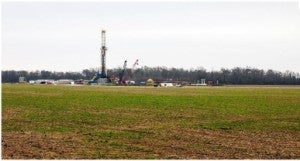This commentary was originally posted on our EDF Voices blog.
Worthy public policy initiatives get announced every day of the week, and reporters mostly greet them with a shrug. But last week’s announcement of a new center designed to set standards for shale gas development in the Appalachian Basin triggered a wave of media attention.
The Washington Post called the Center for Sustainable Shale Development (CSSD), “a heartening breakthrough in the war over fracking.” And the Associated Press wrote: “Some of the nation’s biggest oil and gas companies have made peace with environmentalists, agreeing to a voluntary set of tough new standards for fracking in the Northeast….”
I agree that this is a big deal, and not just because EDF played an important role in the two years of negotiation that led to the formation of this group. It’s a rare to see environmentalists and some of the nation’s biggest energy companies working together to improve the safety of natural gas operations. This coalition is a step in the right direction to better protect the quality of life for people living among the gas fields.
But, I also need to make a few points clear.
First, the standards put forth by CSSD are no substitute for strong regulation and enforcement. Voluntary efforts by industry leaders help distinguish the best from the rest and raise the bar for all, but the only path to full protection of our air, water, and health is regulation and enforcement that apply to all.
Second, some press stories have described CSSD as an “agreement” or “deal” environmental groups have made with industry on fracking. This is not the case. What we’ve agreed to is a set of fifteen standards focused on some of the most pressing problems with shale gas development, and a certification process by which companies would held accountable for complying with those standards in the Marcellus Shale (the nation’s largest shale play located in the Appalachian Basin). Perhaps the constructive working relationship we’ve developed with the companies participating in CSSD will lead to a broader consensus on the full range of challenges confronting communities in the middle of the shale gale. We hope so, but we know we are not there yet.
The fifteen initial standards include measures to reduce harmful emissions, such as methane, improve groundwater monitoring and maximize water recycling, among others. This is just the start – we intend to expand and update these standards over time as new information improves our understanding of what is achievable in protecting ground water, air quality and the climate.
Third, some of our environmental colleagues see the voluntary nature of the new standards as a way for the natural gas industry to avoid real oversight, and I understand their skepticism. But, like I said, CSSD’s standards aren’t being put forward in place of regulation and enforcement. To the contrary, by demonstrating that industry leaders have what it takes to produce shale gas safer, CSSD can help build a broad industry-environmentalist coalition in favor of getting the rules right.
The operative word is “can.” Time will tell how effective this effort is, and whether it is can or should to be replicated elsewhere. The next steps are very important. And the results are what matter. Success will hinge on the integrity of this process. We are committed to setting clear guidelines for a rigorous certification and auditing process.
In our view, there are a variety of ways to address the serious environmental and health concerns at the center of the contentious debate over shale gas. CSSD is just one of them, though I believe there is value in companies voluntarily submitting to periodic environmental performance audits. We hope local communities will insist that natural gas producers be certified, and that mineral leaseholders and landowners only do business with those who are.
For the shale industry, CSSD provides an opportunity to demonstrate that it is living up to its commitments. For the environmental community, the opportunity lies in helping to foster ongoing improvements from within the industry – thus setting a rising bar for all operators to meet.
Up until now, local communities affected by the shale gas boom have had minimal ability to verify claims that drilling practices in their midst were safe. CSSD gives them a chance to do just that.










